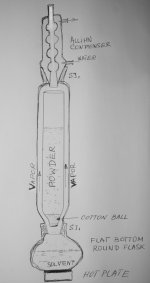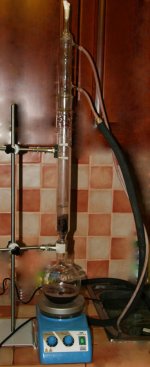With some help from a chemist-friend SWIM has assembled and is about to try a home-made extractor.
As SWIM is not a chemist she doesn't know if a similar device exists and has been used before.
SWIM is just a physisist, so maybe there are some serious flaws in the design and the device would not work.
Comments will be greatly appreciated. The extractor itself is not a standard piece of lab equipment but the idea should be obvious from the attached drawing.
It is planned to do a test extraction of 30-50 g of MHRB using acidified IPA as solvent.
As SWIM is not a chemist she doesn't know if a similar device exists and has been used before.
SWIM is just a physisist, so maybe there are some serious flaws in the design and the device would not work.
Comments will be greatly appreciated. The extractor itself is not a standard piece of lab equipment but the idea should be obvious from the attached drawing.
It is planned to do a test extraction of 30-50 g of MHRB using acidified IPA as solvent.


